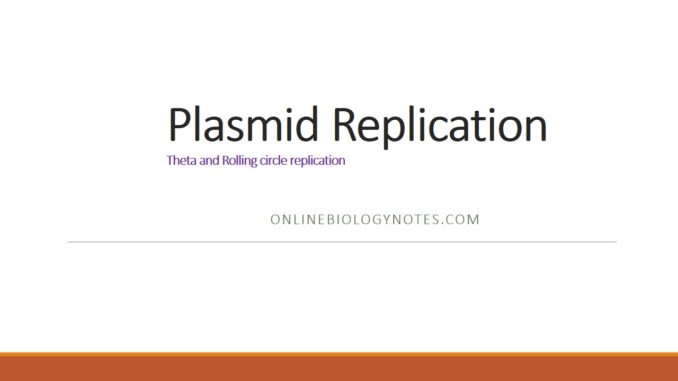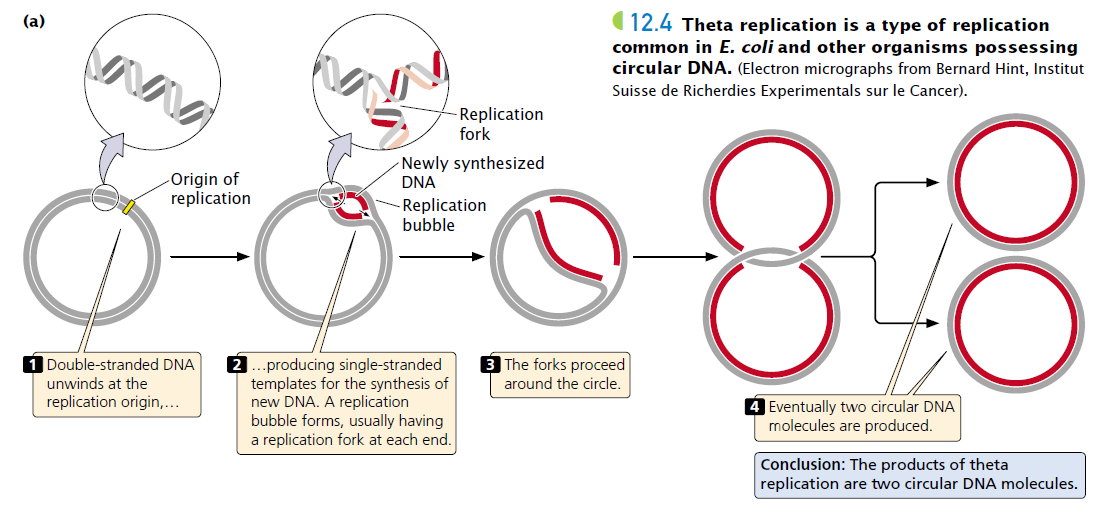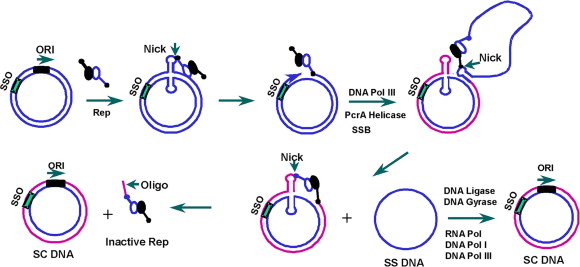
Plasmid Replication
- Those DNA molecules which can replicate autonomously are known as replicons. Example: Plasmids, phage DNA, chromosomes.
- Plasmid can replicate independently.
- Replicons have at least one origin of replication, or ori site, where replication begins.
- The cell also contains the proteins that help to initiate the replication.
- For their replication, plasmids encode only a few of the proteins.
- Many encode only one of the proteins needed for initiation at the ori
- Other required proteins are DNA polymerases, ligases, primases, helicases, etc.
- The plasmid replication origin is often named oriV for ori vegetative, to distinguish it from oriT. oriT is the site at which DNA transfer initiates in a plasmid.
Mechanism of Plasmid replication:
- There are two methods for the replication of plasmids. Among the two mechanisms, replication can occur by any one of the mechanisms:
- theta mode for both unidirectional and bi-directional pathways
- rolling circle mode.
-
Mechanism of Theta Plasmid Replication:
- DNA unwinds at the ori site from where the replication begins.
- It then creates the structure where the whole replicational machinery assembles.
- Since the structure resembles the Greek letter theta (θ), its name has been derived from it.
- The process gets initiated by the RNA primer.
- Then deoxyribonucleotides are added which extends the process.
- The replication process may proceed in one (unidirectional) or both directions (bi-directional).
- In the first case (unidirectional), a single replication fork moves around the circle until it returns to its point of origin. and then the two daughter DNAs separate.
- In the other case (bidirectional replicational) two replication forks begin at ori then it travels to the opposite until they meet at some point on the other side of the molecule.
- This is the most common mode of DNA replication.
- The theta mechanism is the most common form especially in Gram-negative bacteria like the proteobacteria.
- Commonly used plasmids, including ColE1, RK2, and F, as well as the bacteriophage P1, use this type of replication

2. Mechanism of Rolling Circle Plasmid Replication
- It is called rolling-circle (RC) replication because it was first discovered in a type of phage where the template circle seems to “roll”.
- It is a unidirectional process (one direction only).
- Plasmids that replicate by this mechanism are sometimes called RC plasmids.
- This type of plasmid is found in the largest groups of bacteria, as well as in archaea.
- To perform this rolling-circle mode of replication, genetic material needs to be circular.
- In this method, one strand comes out while the other strand is being synthesized.
- Replication starts at the ori site that is the origin of replication where the Rep protein attaches one of the strands.
- Rep protein is the dimer that is formed of the two monomers.
- It has the tyrosine as the active group.
- First, the Rep protein recognizes and binds to the strand that contains the double-strand origin (DSO) on the DNA.
- Then the Rep protein can make a nick in the sequence.
- When the Rep protein has made a break in the DSO sequence, two ends will be formed in the DNA.
- At the 3’ end, there is the presence of OH group while at the 5’ end there is the presence of phosphate group.
- Rep protein will remain attached to the phosphate at the 5’ end of the DNA.
- Then the DNA polymerase III which is the replicative polymerase uses the free 3′ hydroxyl end at the break as a primer to replicate around the circle.
- For the separation of the strand, it may use a host helicase.
- The Rep protein itself may have the helicase activity, depending on the plasmid.
- Once the circle is complete, the 5′ phosphate is transferred from the tyrosine on the Rep protein to the 3′ hydroxyl on the other end of the strand. Then a single-stranded circular DNA is produced.
- This process is called a phosphotransferase reaction and requires little energy. The same reaction is used to re-form a circular plasmid after conjugational transfer.
- The displaced circular single-stranded DNA now replicates by a completely different mechanism using only host-encoded proteins.
- The RNA polymerase of the host cell recognizes the SSO ( single-strand origin) on the DNA.
- Then the RNA polymerase makes a primer.
- Then, replication occurs around the circle by DNA polymerase III.
- The RNA polymerase does not make this primer until the single-stranded DNA is completely displaced during the first stage of replication.
- When the entire complementary strand has been synthesized, the DNA polymerase I remove the RNA primer with its 5′ exonuclease activity while simultaneously replacing it with DNA.
- DNA ligase joins the ends to make another double-stranded plasmid.
- Finally, The two new double-stranded plasmids are synthesized from the original double-stranded plasmid.

3. Replication of linear plasmids:
- Some plasmids and bacterial chromosomes are linear rather than circular.
- The linear DNAs face two problems in all organisms.
- One problem is, at the end of linear fragments, the cell must distinguish the “normal” DNA ends from the ends formed when DNA double-strand breaks occur.
- This condition could be lethal to the cell and must quickly be repaired.
- A second problem with linear plasmids and chromosomes has to do with replicating the lagging-strand template.
- It is the strand that ends with a 5′ phosphate, all the way to the end of the DNA.
- Since DNA polymerases cannot initiate the synthesis of a new strand of the DNA, this has been the “primer problem”.
- They can only add nucleotides to a preexisting primer.
- In a linear DNA, there is no upstream primer on this strand from which to grow.
- The primer problem is solved by the different linear DNA in different ways.
- Some linear plasmids have hairpin ends. They have the 5′ and 3′ ends joined to each other.
- These plasmids replicate from an internal origin of replication to form dimeric circles.
- These dimeric circles are composed of two plasmids joined head to tail to form a circle.
- These dimeric circles are then resolved into individual linear plasmid DNAs with closed hairpins at the ends.
- The hairpin ends are previously not recognized as DNA double-strand breaks.
- It is because they are not targets for exonucleases in the cell.
- A completely different mechanism is also used to maintain linear plasmids in some systems.
- With this mechanism, a special enzyme called a terminal protein attaches to the 5′ ends of the plasmid DNA.
It is interesting that bacteria with linear plasmids also often have linear chromosomes, and the two DNAs replicate by similar mechanisms
